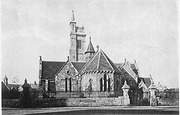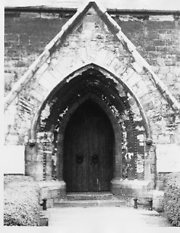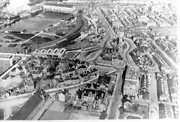 Hartlepool Sports & Leisure
Hartlepool Sports & Leisure
- Cinemas, Theatres & Dance Halls
- Musicians & Bands
- At the Seaside
- Parks & Gardens
- Caravans & Camping
- Sport
 Hartlepool Transport
Hartlepool Transport
- Airfields & Aircraft
- Railways
- Buses & Commercial Vehicles
- Cars & Motorbikes
- The Ferry
- Horse drawn vehicles
 A Potted History Of Hartlepool
A Potted History Of Hartlepool
- Unidentified images
- Sources of information
- Archaeology & Ancient History
- Local Government
- Printed Notices & Papers
- Aerial Photographs
- Events, Visitors & VIPs
 Hartlepool Trade & Industry
Hartlepool Trade & Industry
- Trade Fairs
- Local businesses
- Iron & Steel
- Shops & Shopping
- Fishing industry
- Farming & Rural Landscape
- Pubs, Clubs & Hotels
 Hartlepool Health & Education
Hartlepool Health & Education
- Schools & Colleges
- Hospitals & Workhouses
- Public Health & Utilities
- Ambulance Service
- Police Services
- Fire Services
 Hartlepool People
Hartlepool People
 Hartlepool Places
Hartlepool Places
 Hartlepool at War
Hartlepool at War
 Hartlepool Ships & Shipping
Hartlepool Ships & Shipping

Christ Church
Details about Christ Church
Christ Church, designed by architect Edward Buckton Lamb, was opened in 1854 and closed in 1973. The building, which has a 100 foot tall tower, was refurbished as an Art Gallery in 1996.
Location
Related items () :
 Bridesmaids 1961
Bridesmaids 1961
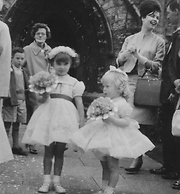 Donated by Mrs. Marian Bunn
Donated by Mrs. Marian BunnDated 1961
Two young Bridesmaids and guests at the wedding of George Metcalfe and Jean Tate, at Christ Church, Hartlepool, in 1961.
More detail » British Legion March on Coronation Day 1937
British Legion March on Coronation Day 1937
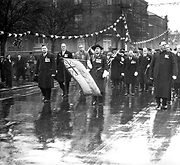 Donated by W. Skidmore
Donated by W. SkidmoreDated 1937
The British Legion marching past the War Memorial in Victory Square, after leaving Church Square, on Coronation Day.The procession would have been led by the Captain G.H. Hayton possibly the person either to the left or right of the Flag Bearer. Visible in the background is The Municipal Buildings in front of Christ Church and to the left The Wesley Church and The Grand Hotel. May 12th 1937.
HHT+N 26
More detail » CND March Church St
CND March Church St
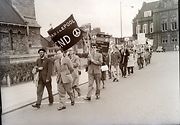 Created by NDM
Donated by Hartlepool Museum Service
Created by NDM
Donated by Hartlepool Museum ServiceTaken around 1954, the image shows a CND march in Church St. Possibly the man with the beard is Walter Gill?
On the left, the United Bus Station can be seen.
More detail » Christ Church
Christ Church
 Donated by Hartlepool Museum Service
Donated by Hartlepool Museum ServiceChrist Church with boundary wall in place.
More detail » Christ Church
Christ Church
Christ Church was the first church built to cater for the newly arrived population of West Hartlepool. It was sited in the centre of Church Square, West Hartlepool. In its early years it witnessed one of Ralph Ward Jackson’s most notorious disputes. In recent years, it has become Hartlepool’s Art Gallery.
The idea for the church
Ralph Ward Jackson, founder of West Hartlepool, wanted a church for his new town. The town had grown rapidly, after the opening of the first dock and harbour, in 1847. By 1851 there were over 4000 people working in the new town; in the next ten years this would increase to over 29,000. Ralph Ward Jackson believed that it was his responsibility to provide for the spiritual needs of the town. He took it upon himself to find the money to build the church.
Edward Buckton Lamb, a respected London architect, won the architectural competition set up by Ward Jackson in March 1852. The winner was commissioned to design the new church. Lamb had worked on similar designs for churches before. His winning design was too large and too expensive for Ward Jackson’s budget. The church building that still stands is from his second design.
Dodgy Finances
It is difficult to work out how much it cost to build Christ Church. The stone to build the church came free of charge from Ralph Ward Jackson’s excavation for Jackson Dock. Ralph Ward Jackson said in 1856 that it cost £8,000 (£385,800 today) of which £7,800 was provided by him, his family and friends. He did not keep separate records of his private income and that of the Hartlepool West Harbour and Railway Company. This failing was to cause him trouble in later years when he was accused of misspending his company’s funds. Ralph Ward Jackson also gave a large sum of money to finance the building of a parsonage in Church Square, which cost £1,200 (£57,867 today) in 1856.
As well as the limestone, pieces of prehistoric “bog oak” (ancient trees preserved in peat) were found during the excavations. The church’s wooden altar rails were made from it. The outside of the church has little decoration other than the anchor on the south gable end of the building. The tower at Christ Church’s western end is 100 feet (30.48 metres) high. The little spire in the south east corner of the tower adds another 25 feet. (7.6 metres.)
A peal of six bells by Taylor and Son of Loughbrough cost £400, (£19,290 today) and the church organ was built by James Langley of Greatham Village (about five kilometres outside Hartlepool). The tower was not fitted with a clock until 1921.
The Church Opens for Worship
The Church was consecrated (opened for worship) at a service conducted by the Bishop of Durham, Bishop Maltby, on 20th April 1854. The prayers were read by Rev. John Hart Burges, the first vicar of Christ Church. When first opened, Christ Church contained 1,000 seats. 700 were available on a subscription basis, the wealthy members of the parish renting seats annually for themselves, their families and servants. 300 seats were free for the poor.
The fight between Ward Jackson and the Vicar
The dispute started between Burges and Ward Jackson over the provision of a parish school connected to Christ Church. The difference of opinion was over whether the pupils should only be from Christ Church parish or, as Ward Jackson wished, from all of West Hartlepool.
The first rector, John Hart Burges was 28 years old when he came to West Hartlepool. He was first housed temporarily in Albert Terrace but never lived in the parsonage, owing to his dispute with Ward Jackson. Burges was given the task of raising money for the school, which he did.
Bricking up the Church Door
Ralph Ward Jackson was not used to being opposed, and the dispute got personal. Each man had his supporters. Jackson discovered that the documents he had prepared for the establishment of Christ Church were based on an act of Parliament from 1831. The act had been amended in 1851, making Jackson’s work null and void. This meant that marriages that took place in Christ Church were invalid, making children from those marriages illegitimate. Both Ward Jackson and Burges put notices on the door of Christ Church. Jackson’s told people to go to Stranton Church to get married. Burges’ said marriages were still taking place in Christ Church. Ward Jackson asked Burges to resign in December 1855, which he refused to do. On Tuesday, 29th July, 1856, Ward Jackson put locks on all the doors of the church. The following day Burges got the Churchwardens to break the locks off. On the same day Ward Jackson then employed men to brick up the doors of the church. By this time there was a crowd present, which was getting rowdy. The men built up the barriers to about half a metre high, before the crowd broke it down again. The local paper, the Stockton and Hartlepool Mercury, was a supporter of Ward Jackson. The paper claimed that Burges’ supporters were drunk and were aping religious ceremonies, doing fake christenings, marriages and sermons. The Durham Chronicle published the opposing view, under the name “Fiat Justicia”, saying that the scandalous events in the church were all Ward Jackson’s fault.
A meeting was held on 6th August which included both Jackson and Burges. Also present was Archdeacon Thorp who was asked to judge the two men’s arguments. The Archdeacon decided that the doors should be replaced by Ward Jackson. Services should continue while the Church authorities came to a decision on how to ensure the Church documents were legal. Jackson took a month to comply, and then did not ensure the job was done properly.
Ward Jackson was still trying to sack Burges, and he eventually succeeded. Burges finally left the town in 1857. A public meeting on 25th March 1857 presented him with a testimonial from his parishioners thanking him for all his hard work.
The Christ Church building today – Hartlepool Art Gallery
Christ Church’s later history is uneventful in comparison with its early years. People moved away from the town centre following the Second World War. The town centre is now mainly shops and offices. The people moved to new houses built on estates, away from the small, cramped terraced houses built as the town grew in the mid 19th century. Many of the streets close to the church were demolished when the area was cleared in the 1970s. The new Fire Station and the College of Further Education and other offices stand on the cleared area. The people’s moving away from the centre of town resulted in the church’s closing in April 1974. Hartlepool Borough Council later acquired it from the church authorities.
Work started in 1994 and the repaired and restored building, costing £2m, reopened to the public on 5th January 1996. It is now an Art Gallery, Tourist Information Centre, cafe and craft and gift shop. The Art Gallery has a changing programme of temporary art and craft exhibitions.
More detail » Christ Church
Christ Church
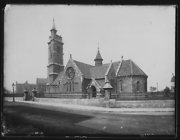 Donated by Hartlepool Museum Service
Donated by Hartlepool Museum ServiceChrist Church, Church Square, with boundary wall.
More detail » Christ Church - 1975
Christ Church - 1975
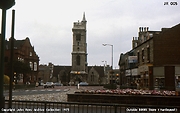 Created by Mr. John Rees
Donated by Mr. John Rees
Created by Mr. John Rees
Donated by Mr. John ReesDated 1975
A view of Christ Church taken from outside Binns Store in 1975.
More detail » Christ Church 1903
Christ Church 1903
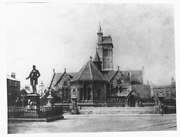 Donated by Douglas Ferriday
Donated by Douglas FerridayPart of the Hartlepool Library Service collection
Christ Church with the Ralph Ward Jacson statue.
More detail » Christ Church 1973
Christ Church 1973
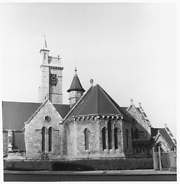 Donated by Douglas Ferriday
Donated by Douglas FerridayPart of the Hartlepool Library Services collection
A view of the north east elevation of Christ Church, showing the vestry, north east porch, north transept, 1973.
More detail » Christ Church 1976
Christ Church 1976
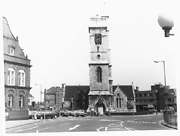 Donated by Douglas Ferriday
Donated by Douglas FerridayPart of the Hartlepool Library Services collection
A view of Christ Church with the Sir Willam Gray statue in the foreground. This photograph was taken from the top of Church Square. The former Barclays Bank is now the Ward Jackson pub.
More detail » Christ Church Hall, Brunswick Street
Christ Church Hall, Brunswick Street
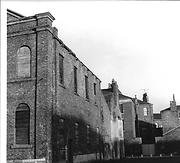 Donated by Hartlepool Library Service
Donated by Hartlepool Library ServicePart of the Library collection collection
Dated 1966
Prior to demolition to make way for the College of Further Education, the image shows the corner of Christ Church Parish Hall in Brunswick Street. The street ran north from Musgrave Street and the hall was close to Albert Street. The buildings in the background were in Tower Street at the point approximately where Charles Dickens Tool Store stands now.
HHT&N 133
More detail » Christ Church Harvest Festival 1962
Christ Church Harvest Festival 1962
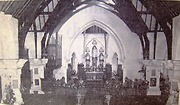 Created by NDM
Donated by Hartlepool Museum Service
Created by NDM
Donated by Hartlepool Museum ServiceDated 1962
Taken in October 1962, the church is decorated for Harvest Festival.
More detail » Christ Church Interior (3)
Christ Church Interior (3)
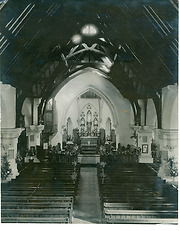 Donated by Hartlepool Museum Service
Donated by Hartlepool Museum ServicePerhaps decorated for harvest festival as there are wheat sheaves at the base of the pillars.
HHT&N 625
More detail » Christ Church Interior (4)
Christ Church Interior (4)
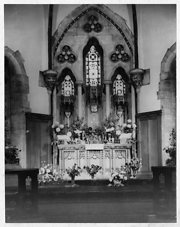 Donated by Hartlepool Museum Service
Donated by Hartlepool Museum ServiceInterior of Christ Church
More detail » Christ Church Interior (5)
Christ Church Interior (5)
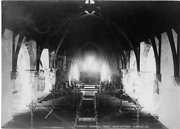 Donated by Hartlepool Museum Service
Donated by Hartlepool Museum ServiceInterior showing pews.
More detail » Christ Church St George's Day parade 1959
Christ Church St George's Day parade 1959
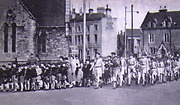 Created by Hartlepool Mail
Donated by Hartlepool Museum Service
Created by Hartlepool Mail
Donated by Hartlepool Museum ServiceDated 1959
This image of a St George's Day parade is quite unusual as it shows Christ Church vicarage on the right. An image in 1960 on these pages shows an empty space as it was soon to be demolished. For some time the site was vacant before Barclays Bank was built on the site. This building was later altered and is now Wetherspoons Ward Jackson pub.
Before demolition, the vicarage had for some years been a Miinistry of Pensions office.
More detail »
 Christ Church Tower
Christ Church Tower
 Donated by Hartlepool Museum Service
Donated by Hartlepool Museum ServiceView of the entrance and the tower of Christ Church.
More detail » Christ Church West Hartlepool
Christ Church West Hartlepool
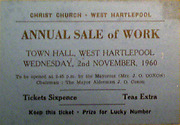 Donated by W Henderson
Donated by W HendersonPart of the Business Cards collection
Christ Church, West Hartlepool. Annual Sale of Work, Town Hall 1960. Tickets cost 6d (around 2p).
More detail » Christ Church c1899
Christ Church c1899
 Donated by Douglas Ferriday
Donated by Douglas FerridayPart of the Hartlepool Library Service collection
A view of the south side of Christ Church with what is now the Municipal Buildings in the background.
More detail » Christ Church interior 1
Christ Church interior 1
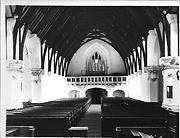 Created by Douglas Ferriday
Part of the Library collection
Created by Douglas Ferriday
Part of the Library collectionTaken from the altar area, the view looks towards the main doorway. In 1994,along with the renovation of the church which closed in June 1973, the balcony area became part of the stairway to the tower for visitors.
More detail » Christ Church interior 2
Christ Church interior 2
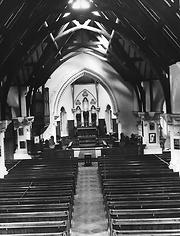 Created by Douglas Ferriday
Part of the Library collection
Created by Douglas Ferriday
Part of the Library collectionTaken from the door looking towards the altar.
More detail » Christ Church organ
Christ Church organ
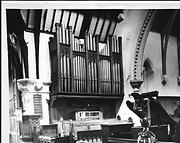 Donated by Douglas Ferriday
Donated by Douglas FerridayPart of the Library collection
The eagle lecturn still remains on display in the church which is, since 1996, Hartlepool Art Gallery.
More detail » Christ Church with Gray statue in front
Christ Church with Gray statue in front
 Donated by Douglas Ferriday
Donated by Douglas FerridayPart of the Hartlepool Library Service collection
Christ Church with Sir William Gray's statue in front.
More detail » Christ Church, c1910, with Horse Drawn Cabs
Christ Church, c1910, with Horse Drawn Cabs
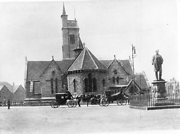 Donated by Hartlepool Library Service
Donated by Hartlepool Library ServiceChrist Church with Horse Drawn Cabs waiting for fares. Ralph Ward Jackson statue in picture.
HHT&N 625
More detail » Church Square
Church Square
 Part of the Hartlepool Museum Service collection
Part of the Hartlepool Museum Service collectionLooking towards Christ Church from Stockton Street probably in the early 1900s. Christ Church is in the centre, the Municipal Buildings on the left and the shops and Masonic Lodge on the right. THe only building no longer there is Church Square School which is at the end of the right hand terrace.
More detail » Church Square Procession
Church Square Procession
 Created by NDM
Donated by Hartlepool Museum Service
Created by NDM
Donated by Hartlepool Museum ServiceProcession of Witness in Church Square on the corner of Tower St in the early 1950s.
The photo shows Christ Church vicarage to the left of the shops.This was demolished later in the 1950s and eventually Barclays Bank was built on the site. This in turn was renovated and is now the Ward Jackson pub. There is a wonderful advert for Stokell decorators on the wall of the toy shop which was Andrew C Watt, although the name is not there at the time.
There are trolley bus lines on the left.
More detail » Church Street
Church Street
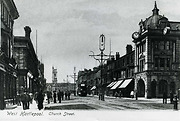 Donated by Hartlepool Library Service
Donated by Hartlepool Library ServiceView looking up Church Street, Christ Church at top of image. On the left of the image we have the Shades pub and that just up we have the Atheneum. On the right the Old Yorkshire Penny Bank taken before the bombings during WWII
HHT+N 173
More detail » Church Street 1910
Church Street 1910
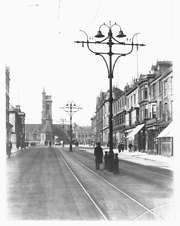 Donated by Douglas Ferriday
Donated by Douglas FerridayPart of the Hartlepool Library Service collection
View of Church Street looking up towards Christ Church. There is a tram showing in front of Christ Church.
HHT&N 81
More detail » Church Street and Church Square - glass plate
Church Street and Church Square - glass plate
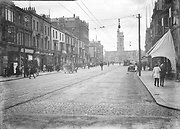 Donated by Mr. Andrew Rogers
Donated by Mr. Andrew RogersA view of Christ Church from Church Street in the late 1920s. This is an image taken from one of a number of glass plate negatives found in Frank Wright's shop in York Road, in the 1960s. The plates are believed to originate from the 1890s.
HO4111
More detail » Church Street around 1880
Church Street around 1880
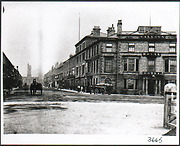 Part of the Hartlepool Museum Service collection
Part of the Hartlepool Museum Service collectionAn early view of Church Street looking towards Christ Church shows Gallon's Royal Hotel which the became The Royal. Although the pub is still open on the side facing Church Street, this facing side is now residential flats. This rather grand frontage originally faced Albert Square which was to have been the centre of Ward Jackson's new West Hartlepool. However, the railway was built across the square and the town developed to the west leaving the grand frontage facing a railway line.
The cart in front of the hotel says 'Hartlepool to West Hartlepool'
More detail » Church Street from Christ Church Tower 1966
Church Street from Christ Church Tower 1966
 Donated by Douglas Ferriday
Donated by Douglas FerridayPart of the Hartlepool Library Service collection
Church Street from Christ Church Tower 1966
More detail » Demolition of Christ Church Vicarage
Demolition of Christ Church Vicarage
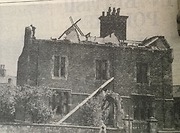 Created by NDM
Donated by Hartlepool Museum Service
Created by NDM
Donated by Hartlepool Museum ServiceDated 1960
Taken in 1960, the image shows the demolition of Christ Church vicarage. Barclays Bank was built in the site in Church Square and thus building has since been transformed into Wetherspoon's Ward Jackson public house.
More detail » First design of Christ Church
First design of Christ Church
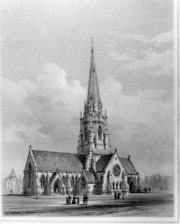 Donated by Hartlepool Museum Service
Donated by Hartlepool Museum ServiceFirst design of Christ Church taken from a book.
More detail » Mother and Daughter
Mother and Daughter
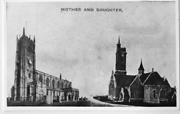 Donated by Hartlepool Museum Service
Donated by Hartlepool Museum ServiceA post card with a picture of Christ Church and St Oswalds Church on it entitled 'Mother and Daughter'
More detail » Mothers'Union Parade
Mothers'Union Parade
 Created by NDM
Donated by Hartlepool Museum Service
Created by NDM
Donated by Hartlepool Museum ServiceTaken in the mid 1950s, the image shows a parade with Mothers' Union ladies and their banner in Church Square. Behind the ladies, Christ Church Vicarage can be seen. This was later demolished, Barclays built a bank on the site and this in turn became the Ward Jackson pub.
More detail » Parish Hall Christ Church
Parish Hall Christ Church
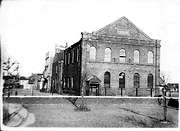 Donated by Sep Yuill
Donated by Sep YuillThe hall was in Brunswick Street and this photo was possibly taken just before demolition and after the area around the College of Further Education was landscaped.
More detail » Procession in Church Square
Procession in Church Square
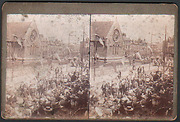 Part of the Hartlepool Museum Service collection
Part of the Hartlepool Museum Service collectionOutside Christ Church, the image is probably the Royal Visit in 1889 by Prince Albert Victor like the image outside the Municipal Buildings. Like this image it is 'stereoscopic'.
More detail » Ralph Ward Jackson Statue
Ralph Ward Jackson Statue
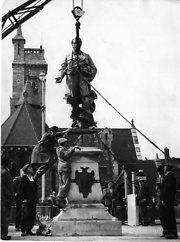 Donated by Hartlepool Museum Service
Donated by Hartlepool Museum ServicePart of the Photo Box 6 collection
The statue of Sir Ralph Ward Jackson being lowered onto it's pedestal in Church Street in the 1950's. Christ Church can be seen in the background.
More detail » Ralph Ward Jackson Statue
Ralph Ward Jackson Statue
 Donated by Hartlepool Museum Service
Donated by Hartlepool Museum ServiceRalph Ward Jackson, founder of West Hartlepool & the driving force behind the erection of Christ Church which is in the background.
More detail » Roll of Honour- Christ Church, West Hartlepool
Roll of Honour- Christ Church, West Hartlepool
 Donated by Brian Barlow
Donated by Brian BarlowPicture of a document produced by Barlows Printers for Christ Church, West Hartlepool. The document lists members of the church congregation who served King and County in The Great War, 1914-1916. Alfred. E. Barlow, of The Royal Horse Guards, is on the list. Alfred was the son of the well known local printer William Barlow. Alfed was captured by the Germans, but returned home and later married Ethel Matthews of Scarborough. Her family owned The Esplanade Hotel. Alfred later became mayor of Scarborough.
More detail » Upper Church Street c1900
Upper Church Street c1900
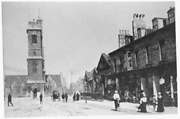 Donated by Douglas Ferriday
Donated by Douglas FerridayPart of the Hartlepool Library Services collection
Upper Church Street, c.1900 with shops on the right and Christ Church on the left.
More detail » Vicar and Choir of Christ Church
Vicar and Choir of Christ Church
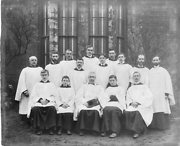 Donated by Hartlepool Museum Service
Donated by Hartlepool Museum ServiceVicar and Choir of Christ Church. No other details known.
More detail » View from the Coal Staithes
View from the Coal Staithes
 Donated by Hartlepool Library Service
Donated by Hartlepool Library ServiceA view from the top of the coal staithes over the coal dock. The Custom House can be seen as well as Christ Church spire.
HHT+N 707
More detail » Wedding - David Watson and Marian Grey Davison (2)
Wedding - David Watson and Marian Grey Davison (2)
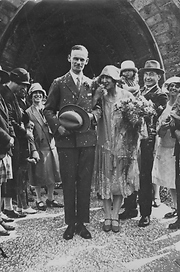 Donated by Mr. John Watson
Donated by Mr. John WatsonDated 1927
Davis and Marian outside Christ Church. Just behind Marian is Tom Soulsby, holding his young daughter Josephine, and just behind Tom is Amy Gales (nee Keenan).
More detail »






